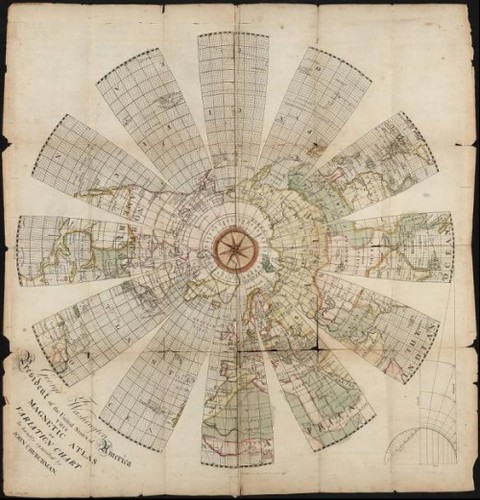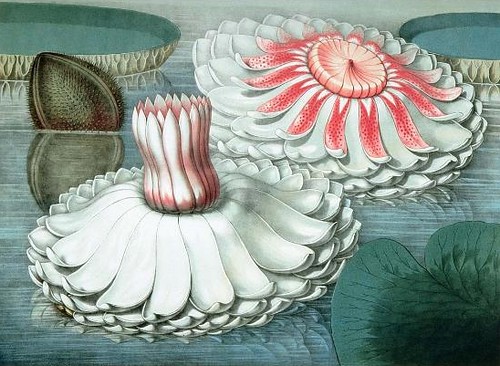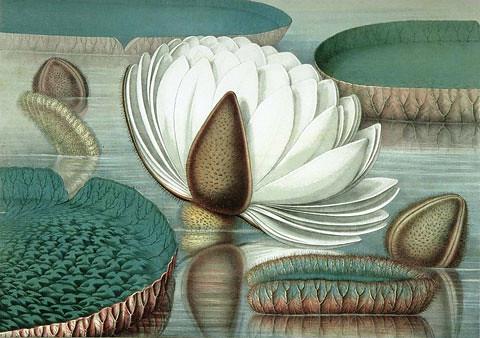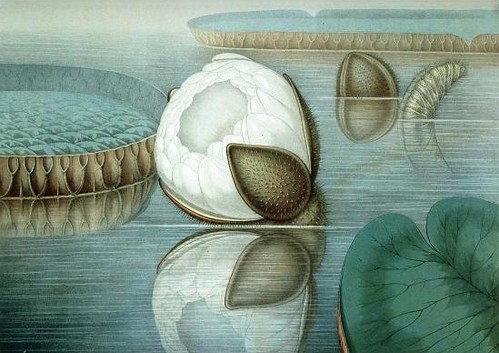



Featuring such enduring characters as Pulcinella, Scaramouche, Capitano, and Pantalone from the theatrical tradition of Commedia dell'Arte, these microfilm scans depict scenes by artist Johann Jacob Schübler and engraver Georg Balthasar Probst from the early 18th century. They are to be found in the extensive (but not overly intuitive) Cesar website, devoted to French theatre from the 17th and 18th centuries. The collaborative site draws images and information from a wide variety of institutions. [I've saved a few more illustrations, including a couple of colour images, in this webshots album]
The book: 'An explanation of the magnetic atlas, or variation chart, hereunto annexed : projected on a plan entirely new, by which the magnetic variation on any part of the globe may be precisely determined, for any time, past, present, or future : and the variation and latitude being accurately known, the longitude is of consequence truly determined / by John Churchman, late land surveyor for the district of the counties of Delaware and Chester, and for part of Lancaster and Berks, Pennsylvania.' 1790.
This half-globe gore map is, I recall, the only illustration in the book. Clicking on the above image ought to take you direct to the Library of Congress page in question (or here, if needed). An enormous version is available.



These are the only illustrations from 'Arzneibüchlein' (Medicinal Booklet) by Klaus von Matrei from 1540 at the University of Heidelberg.
We will not have a catt to live.

More scenes from the monde renversé tradition. The first is the most recent image of the month at British Printed Images, and as usual, they provide quality background information. The second image, floating around on my computer for ages, comes from somewhere in the Dutch Mnemosyne database.

Charles Dickens' last unfinished novel 'The Mystery of Edwin Drood' is available online in various forms, but Jessica L Miller has been uploading the original serialised version - I love all the old advertisements. The original illustrations in the book were by Samuel Luke Fildes and the instalments were published by Chapman & Hall in 1870.


Venetian composer, Gioseffo Zarlino, was the most celebrated musical theorist of the mid-1500s. While his theoretical writing on counterpoint, harmonics and tuning are far and away outside my very limited understanding, 'Le Istitutioni Harmoniche', first published in 1558, brought him instant fame. The book is available from the University of Strasbourg and contains quite a few illustrations. It always strikes me that early works on musical theory had the most logical and advanced graphical representations. That may just be an extension of my ignorance however.

This is the frontispiece from 'Judas der Ertz-Schelm' by Abraham St Clara (pseudonym of Ulrich Megerle). Megerle is said to have been a popular preacher because of the gruff weekly sermons he gave for ten years denouncing Judas, which apparently ended with a savage criticism of Judas's physical appearance - his red hair etc etc. This is the only image in the book, from the University of Heidelberg.





'Victoria Regia or The Great Water Lily of America' 1854, with text by John Fisk Allen and six chromolithographs (some of the earliest printed in America) by William Sharp. Sharp used four separately inked stones to render the exquisite illustrations on elephant folio sheets.
The first image above comes from the Carter Museum - I couldn't decide which illustration was better. The others are all via the Spencer Art Museum at Kansas University* but are displayed, along with the text, at Victoria-Adventure. Their whole site is worth exploring, particularly the historical articles (halfway down) that give some indication as to the difficulties facing hopeful 19th century cultivators and the (understandable) awe in which the the Victoria lilies were held.
"It would not be extravagant to call the beauties of this plant unsurpassable. Like the gigantic idea its leaf-structure originated -- the Crystal Palace -- it stands among its class alone and unapproachable. Its flower has been compared to a colossal specimen of the night-blooming Cereus, (Cereus grandiflora.) In certain respects this comparison is just, as in the general appearance of the flower and its delightful fragrance; but when we proceed to examine each beauty separately, all comparison with any other flower must cease. It is not possible to select one property more than another, the which most to admire. It is everything to be wished for."

Charcoal on paper (1923-1925) by János Máttis-Teutsch.
There is a lot more than just cubist typographical figures in the 'Mattis Teutsch and Der Blaue Reiter' exhibition site from the Hungarian National Gallery in Budapest (2001).

Imagining the Korean DMZ © Lebbeus Woods via a wonderful interview by Geoff Manaugh at BldgBlog and also the (now) Sydney-based City of Sound.

From: 'Album of Miss Eliza Younghusband, South Australia, 1856-1865' at the National Library of Australia - a sort of sketch and scrap album with ~60 images, including a couple of drawings by a member of the Burke and Wills expedition.

"The New Astrology: Cosmic Key of Life Symbol. A. S. Vickers. 1930. Detail.
Lessons in reading your solar and color horoscope.
American Religions Collection, Department of Special Collections, University of California, Santa Barbara Libraries."

"'Snowy Heron or White Egret' Painted in Charleston in 1832 by John James Audubon and George Lehman. Engraved by Havell. From Birds of America, v. 3. 1835.
Lehman’s background depicts a South Carolina low-country plantation.
Audubon's Birds of America, Department of Rare Books and Special Collections, University of South Carolina Libraries."
These last two images are from a brand new and exemplary website - Celebrating Research - "a sampling of the remarkable abundance of collections available for use in the member libraries of the Association of Research Libraries". They give an overview of the collections held in North American repositories and, from a couple of images I checked, they seem to be displaying works not necessarily available from the source institutions themselves. Great site.
A couple of other things...
- A local shoutout - if you have an overwhelming desire to know what happens when you combine Jane Austen, Germaine Greer and comedy, and you will be in Melbourne at the end of November, then you should check out the Austen2007 site {flier} (organised by Sarsaparilla's own Lucy Tartan).
- Caricatures et Caricature. Le Blog.
- Deanna Molinaro's Not-For-Children-Books [via]
- Intricate Silhouettes - a great post with a wealth of paper cut art links from nickyskye.
- Khatt Network for Arabic Typography - from Holland.
- Historic Illustrations of Art and Architecture at the University of Michigan - "The historic illustrations included in this project were originally published during the late nineteenth and early twentieth centuries. [..] These engravings, line drawings, and plans reflect both the technological and aesthetic standards of their time. By their very nature, they often represent subjective interpretations of the monuments and works depicted, and as such they offer fascinating insights into the cultural values of art and architectural history during the formative years of these disciplines."
- Idbury Prints is a commercial gallery site but they have some unique material, reasonably sized images for viewing, background information and the ability to browse by style, medium or subject matter.
- I think there's more than even chance I've posted a couple of these images before (resistant to searching) but I'm pretty sure these versions are better and at least they are now well labelled.



















No comments :
Post a Comment
Comments are all moderated so don't waste your time spamming: they will never show up.
If you include ANY links that aren't pertinent to the blog post or discussion they will be deleted and a rash will break out in your underwear.
Also: please play the ball and not the person.
Note: only a member of this blog may post a comment.